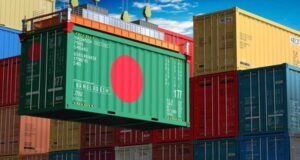
Spot market LNG imports could cost Bangladesh about $11 billion between 2022 and 2024, according to a mini briefing published by Ember, a global energy think tank.
Heavy reliance on gas generation, diminishing domestic gas reserves, lack of alternative renewable generation capacity and new coal power becoming increasingly unviable have all led Bangladesh to rely more and more on Liquefied Natural Gas (LNG) imports to meet its energy needs.
Data from the government’s Energy and Mineral Resources Division shows that by Financial Year (FY) 2022, Liquid Natural Gas (LNG) imports accounted for 22% of the country’s total gas requirement. Furthermore, IEEFA’s recent analysis showed that about 59% of its LNG imports come from the spot market, opening itself to price volatility risk.
With the global LNG price skyrocketing in recent years, Bangladesh is being priced out of the spot market and forced to impose austerity measures. This situation is likely to persist for several more years as Bloomberg New Energy Finance reports that the country is likely to see gas shortages till 2026.
Bangladesh aggressively expanded its gas-based generation in the last decade to meet its rising electricity demand. Ember’s Data Explorer shows that Bangladesh’s electricity demand rose at an average annual growth rate of 8%, from 42 TWh in 2011 to 90 TWh in 2021. About 62% of this growth was met through gas power, pushing its share in the electricity mix to 63% in 2021. Exploration of large amounts of domestic reserves in the previous decades made this possible, but Bangladesh’s domestic gas production is now unable to keep up with the increasing gas demand. With its gas reserves drying up, its domestic gas production peaked in 2015-16 and the country started importing LNG from 2018-19. Eventually, it started purchasing LNG from the spot market from 2020 to meet the growing demand.
By contrast, renewable energy (RE) generation saw only marginal growth in the last decade. As a result, it accounted for just 1% of Bangladesh’s total power generation in 2021 – split equally between hydro and solar power. This minimal growth in domestic RE meant Bangladesh’s power imports surged to keep up with its growing electricity demand, weakening the country’s energy security.
Bangladesh plans to import 30 cargoes of LNG from the spot market in 2022, equating to approximately 4.14 million cubic metres (mcm). Assuming that Bangladesh’s annual spot market LNG imports do not increase and remain stable over the next two years, about 12.42 mcm LNG would have to be imported through the spot market between 2022 and 2024. Based on the actual spot LNG prices so far this year and future LNG prices till 2024 according to the current LNG forward curve from LNG Japan/Korea Marker, Bangladesh could have to foot a bill of $11 billion just on spot gas imports.
This number could be even higher if Bangladesh’s reliance on the spot market for LNG continues to increase in line with the current trend evident from Rupantarita Prakritik Gas Company Limited (RPGCL) data. With domestic gas production falling every year and long-term LNG suppliers from abroad increasingly looking to supply minimum contractually obligated volumes in the mid-term to achieve higher profits elsewhere, there is a risk that spot market LNG requirement actually increases even further.
In 2021, Bangladesh launched Mujib Climate Prosperity Plan (MCPP) with pathways to improve the country’s climate resilience. Its ambitious MCPP-M scenario assumes that Bangladesh can achieve 80% of its self-determined maximum possible RE share in the electricity mix by 2030, and recommends a solar capacity target of 2.7 GW by 2025. Following this trajectory would have generated 9.4 TWh of additional solar power between 2022 and 2024 compared to the current trajectory. This would push down spot-market LNG import requirements during this period by a quarter (3.1 mcm), reducing the imported gas costs by $2.7 billion.
Similarly, if Bangladesh followed its more conservative MCPP-R trajectory, where only 50% of the maximum attainable RE share by 2030 is achieved, its LNG imports from spot markets would reduce by 18% (2.2 mcm), reducing the import costs by about $1.8 billion.
Global Energy Monitor (GEM) data shows that Bangladesh is building 4.7 GW of new gas-fired power plants as of July 2022, with a further 23.6 GW in the pipeline. With global LNG prices expected to remain high and volatile, such a step-up will not only further deteriorate Bangladesh’s energy security but also lock-in excess capacity, investment and policies. Bangladesh also has 8.8 GW of coal capacity in construction or pre-permit stages and a further 6.4 GW announced as of July 2022, all of which are expected to run on imported coal, mostly from China, as per GEM’s Global Coal Plant tracker. This will mean that the country may even have to depend upon imported coal for 20 to 30 years – the lifetime of coal plants.
By comparison, Bangladesh’s RE pipeline seems relatively small. In its updated NDC submission in 2021, Bangladesh committed to 4.1 GW RE by 2030 contingent on international support, up from the current level of 0.5 GW. While this is a step in the right direction, it will not be enough to help Bangladesh shake away gas and coal dependency. Given that there is currently substantial gas and coal over-capacity already built into the power system, it can afford to redirect some of the government financing to develop domestic RE capacity.
What is clear from the current crisis is that Bangladesh needs to diversify its energy mix in a more sustainable way. This is critical to ensure the country’s energy security improves, energy costs reduce and the overall power system stability increases.
A practical breakthrough is also required to allow the RE market to grow. For this, the government needs to address various supply-side issues such as insufficient grid infrastructure, lack of flexible capacity to accommodate rising outputs from variable renewable energy, and oversupply in the domestic electricity market.
For Bangladesh to shake off its fossil fuel reliance and build a sustainable, reliable and affordable electricity supply, especially solar, international financing in RE and flexibility is absolutely critical. Investing in solar makes sense for the financiers too as the investments are likely to be paid off quickly.
India is currently building solar power plants at an average cost of $560 million/GW. Even if such projects cost 50% more in Bangladesh and if we assume flexibility and grid augmentation costs double the overall project cost, about 6.5 GW of solar could still be installed with the same $11 billion, which Bangladesh might have to spend on spot market LNG purchases in just 3 years.
 Weekly Bangla Mirror | Bangla Mirror, Bangladeshi news in UK, bangla mirror news
Weekly Bangla Mirror | Bangla Mirror, Bangladeshi news in UK, bangla mirror news







